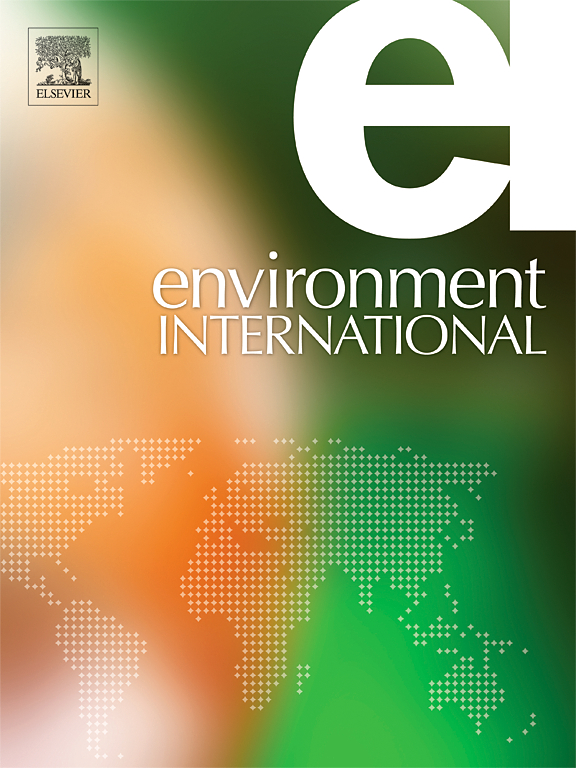Droughts and PM2.5 air pollution in California: the roles of wildfires
IF 10.3
1区 环境科学与生态学
Q1 ENVIRONMENTAL SCIENCES
引用次数: 0
Abstract
Although individual relationships between droughts, wildfires, and ambient PM2.5 air pollution have been reported, the role of wildfires in the pathways from droughts to PM2.5 remains uncertain. This study investigated the association between droughts, defined by the Standardized Precipitation Evapotranspiration Index (SPEI), and PM2.5 concentrations in California, U.S., from 2006 to 2020. A generalized linear mixed model showed that PM2.5 concentrations increased by 1.47 μg/m3 (SE = 0.10; p < 0.0001), on average, as drought conditions intensified by 1 unit of SPEI (lower SPEI values indicating drier conditions and greater drought severity). In stratified analysis, drought-related PM2.5 increases were larger during wildfire days [3.29 μg/m3 (SE = 0.36)] compared to non-wildfire days [0.97 μg/m3 (SE = 0.08)] per unit decrease in SPEI. The likelihood of wildfire-impacted days increased by 89.9 % [odds ratio (OR) = 1.899] per unit decrease in SPEI, rising with the severity of droughts. On wildfire days, wildfire-induced PM2.5 increased by 3.11 μg/m3 (SE = 0.33) per unit decrease in SPEI, on average. Wildfires were a crucial contributor to the drought-related PM2.5 increases, as supported by the decline in the association per unit decrease in SPEI from 3.29 μg/m3 (p < 0.0001) to −0.10 μg/m3 (p = 0.1307) after adjusting for wildfire-induced PM2.5 during wildfire days. PM2.5 increases due to droughts and wildfires pose substantial challenges for air quality management because the likelihood of PM2.5 exceedance days was elevated by wildfires during droughts (OR = 2.978 per unit decrease in SPEI). Understanding the role of wildfires informs air quality management in preparation for future droughts and wildfires.


加州的干旱和PM2.5空气污染:野火的作用
尽管已经报道了干旱、野火和环境PM2.5空气污染之间的个别关系,但野火在从干旱到PM2.5的路径中的作用仍然不确定。本研究调查了2006年至2020年美国加利福尼亚州标准化降水蒸散发指数(SPEI)定义的干旱与PM2.5浓度之间的关系。广义线性混合模型表明PM2.5浓度增加1.47 μg/m3 (SE = 0.10;p <; 0.0001),平均而言,随着干旱条件加剧1个单位SPEI (SPEI值越低表明干旱条件越干燥,干旱严重程度越高)。在分层分析中,与干旱相关的PM2.5在野火日每单位SPEI的增加[3.29 μg/m3 (SE = 0.36)]大于非野火日[0.97 μg/m3 (SE = 0.08)]。每单位SPEI减少,野火影响日数的可能性增加89.9 %[比值比(OR) = 1.899],随干旱程度的加重而增加。野火日,PM2.5平均每单位SPEI下降增加3.11 μg/m3 (SE = 0.33)。野火是导致干旱相关PM2.5增加的关键因素,在调整野火引起的PM2.5后,SPEI单位减少的关联从3.29 μg/m3 (p <; 0.0001)下降到- 0.10 μg/m3 (p = 0.1307)。干旱和野火导致的PM2.5增加给空气质量管理带来了重大挑战,因为干旱期间野火增加了PM2.5超标天数的可能性(OR = 2.978 /单位SPEI减少)。了解野火的作用有助于空气质量管理,为未来的干旱和野火做好准备。
本文章由计算机程序翻译,如有差异,请以英文原文为准。
求助全文
约1分钟内获得全文
求助全文
来源期刊

Environment International
环境科学-环境科学
CiteScore
21.90
自引率
3.40%
发文量
734
审稿时长
2.8 months
期刊介绍:
Environmental Health publishes manuscripts focusing on critical aspects of environmental and occupational medicine, including studies in toxicology and epidemiology, to illuminate the human health implications of exposure to environmental hazards. The journal adopts an open-access model and practices open peer review.
It caters to scientists and practitioners across all environmental science domains, directly or indirectly impacting human health and well-being. With a commitment to enhancing the prevention of environmentally-related health risks, Environmental Health serves as a public health journal for the community and scientists engaged in matters of public health significance concerning the environment.
 求助内容:
求助内容: 应助结果提醒方式:
应助结果提醒方式:


